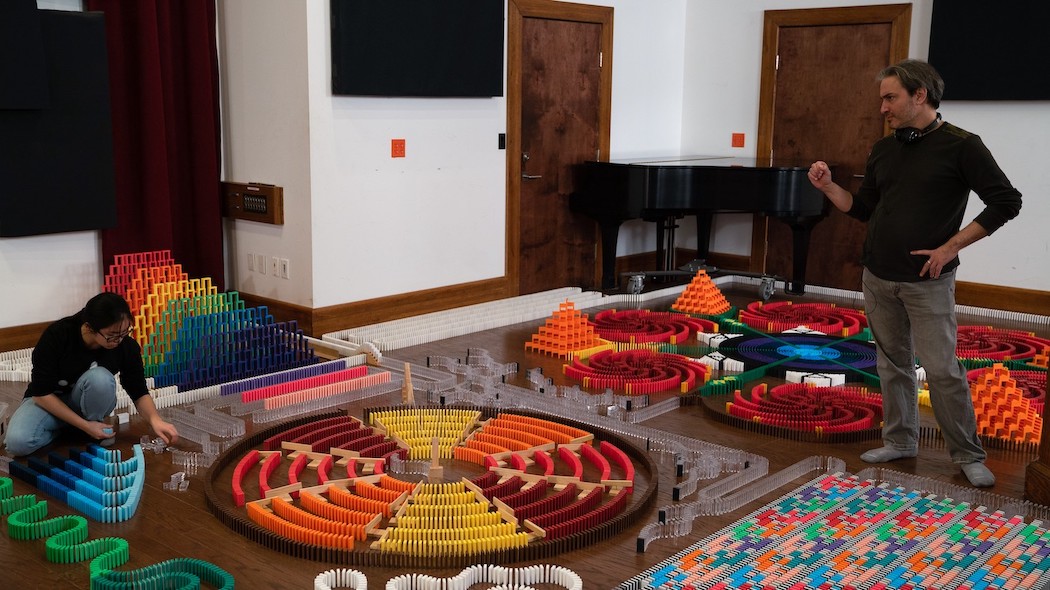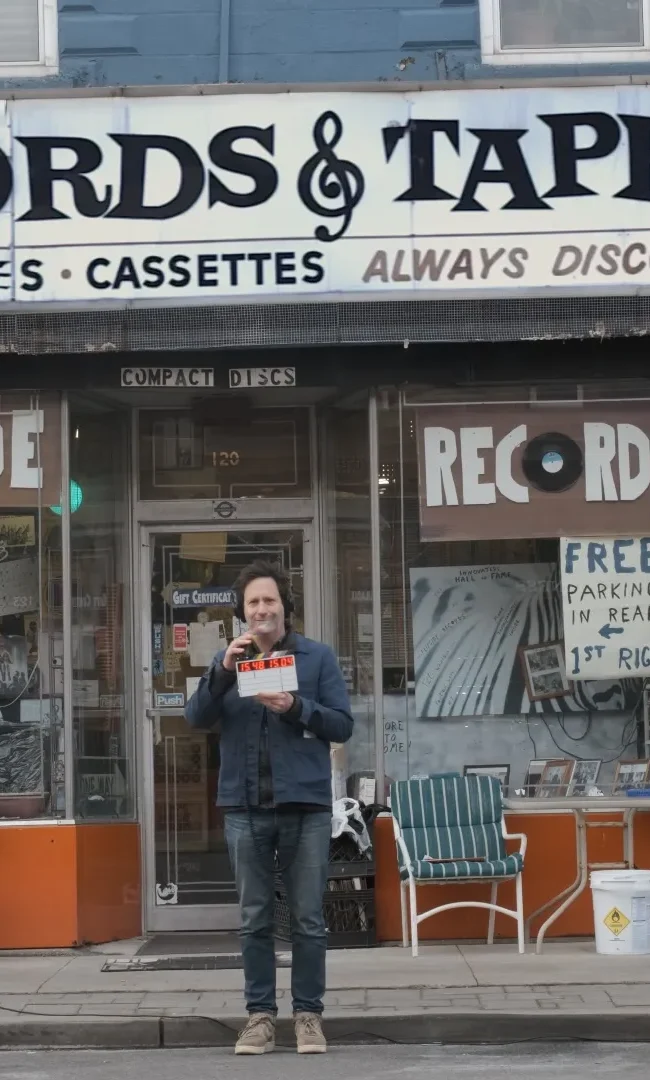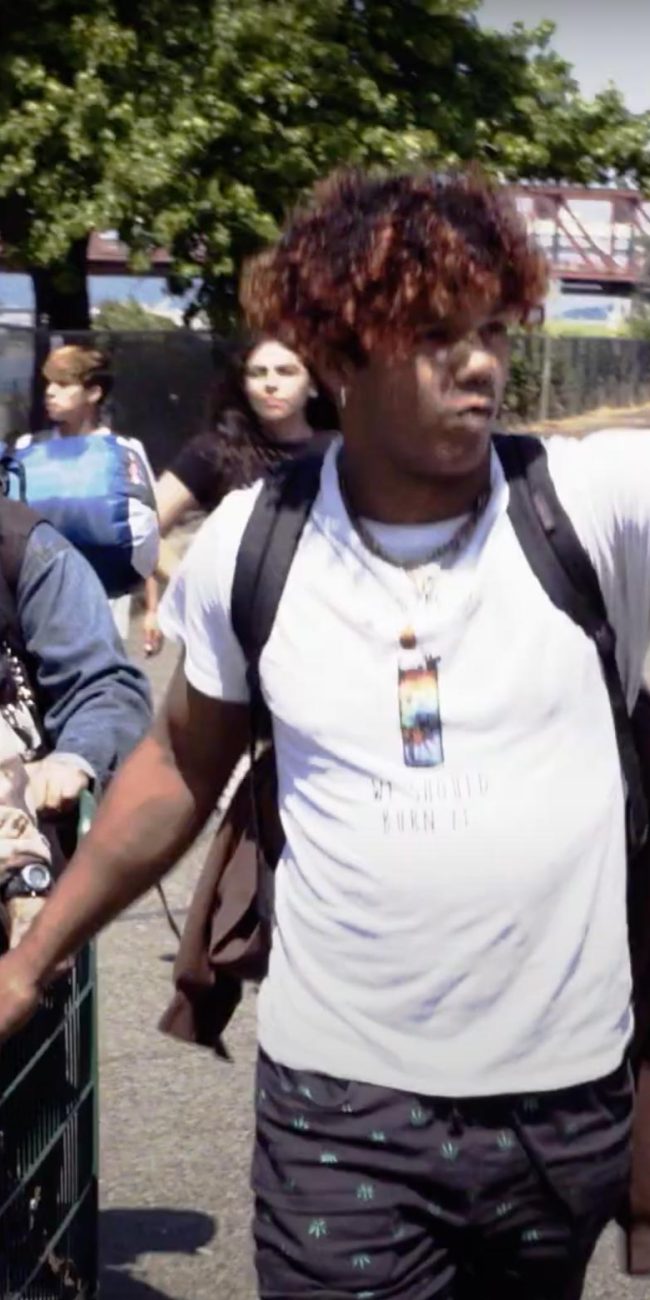A Conversation with Jeremy Workman & Lily Hevesh (LILY TOPPLES THE WORLD)

The week before SXSW 2021 began, I spoke by Zoom with director Jeremy Workman about his latest documentary, premiering at the festival, entitled Lily Topples the World (which I also reviewed). Joining us was his primary subject, Lily Hevesh, one of the great stars of the domino world, with over 3 million subscribers to her Hevesh5 YouTube channel. Their collaboration results in a lively profile of a young woman with a real knack for kinetic sculpture. Here is a condensed digest of our conversation, edited for length and clarity.
Hammer to Nail: When last we met in person, Jeremy, at SXSW 2018, you had just completed The World Before Your Feet, and I’m curious how you went from following Matt Green around New York City to tracking the subject of your new doc, Lily Hevesh, around the globe.
Jeremy Workman: Yeah, I was already working on Lily Topples the World when I was at SXSW with The World Before Your Feet, in fact. For those in Austin, I remember being at that coffee place across from the Alamo Lamar. And I was literally in there, in their backyard, all afternoon, planning and scheduling and crewing up for this big shoot that Lily was doing in Seattle the next week. As you know, I’m really interested in people with really passionate interests and what that means to them and what that says about those people, and I was always interested in the world of domino art, particularly on YouTube. And as I quickly found out, all roads kind of lead to Lily and that immediately created in me this question of, “Who is this girl? And wow, oh my God she’s so awesome.” And then we connected and from there just started this sort of three-year journey to make this movie.
HtN: Was that the Washington State Lottery shoot that we see in the film?
JW: It was, yeah.
HtN: So, Lily, how did Jeremy approach you and pitch this project?
Lily Hevesh: So, I remember he sent me an email, and I was in college at the time, and I think it was like a really informal email. He didn’t use capital letters and he was just like, “Hey, I’m a filmmaker. I’m working on a documentary. I’d love to do one on you for my next one. Maybe we can talk about it.” Something like that, very informal, and I think I was busy in college, so I didn’t respond right away, and then Jeremy actually had to email me again to ping me and be like, “Hey, just wanted to follow up on this.” Which was kind of funny, like, it almost got slipped under the rug for a quick minute. And then, soon after, like a few weeks later, I think he went to our house and we met in person and we talked about the documentary and how the process would go with filming, and we really liked it. We jumped on board and now we have a film.
JW: Yeah, it’s funny because I had never approached a subject as a fan. All my films have been about people that I either knew or were friends of mine or stuff that I was sort of approached about. Somebody would hire me to go, “Could this be a documentary?” This was like truly the first time in my life where I was just such a fan. And I said, “Well, of course, I want to spend the next three years making a movie about this.” So it was different for me, as well.
HtN: I’m wondering if the key to putting a potential documentary subject at ease is to send that level of informal email without capitalization. (laughs) Do you think that works, Lily?
JW: (laughs) I thought, aren’t all Gen Z-ers into not using capital letters?
LH: (laughs) Yeah, it’s a thing. But I guess, if someone else is filming a documentary where you’re the subject, it does help if the director isn’t as formal so you can kind of go with the flow and just be very casual and be yourself. I think he set that tone pretty early on at the start, which made me feel better about it.
JW: Lily’s got this huge YouTube footprint, she’s essentially what we’d probably classify as a YouTube star, right? So, I think the approach of the movie was, “OK, well, how do we look at her differently? How do we look at somebody who’s having this kind of success in this medium, but approach it in a different way, in a way that is more informal, more personal, more about breaking down some of those boundaries?” And that’s what the approach was for the film, overall.

Lily Hevesh in a scene from LILY TOPPLES THE WORLD.
Photo credit: Monica Hudson
HtN: I just checked, Lily, and you have 3.13 million subscribers as of right this moment. So yes, I think that makes you a bona fide YouTube star, and congratulations on that. So, Jeremy, in the film you list Kelly Marie Tran as an executive producer, and that credit means different things for different projects. It could just be somebody who owned the rights to a novel who is given executive-producer status on a film, but in a documentary it could be quite different. So, what exactly is her connection to this movie?
JW: We had sort of mutual acquaintances who brought it to her and said, “Kelly is going to really love this movie.” And I was flattered, going, “Oh, I’m such an awesome filmmaker, of course that’s why she’s going to love ..” (laughs) Really, why she was so excited was because she’s very, very interested in amplifying voices that are maybe not always heard in the media. And that’s what she wants to use a lot of her influence and her fame to sort of help augment. And she saw the movie and loved it. She loved Lily, and she was just like, “I want to be involved. I don’t know how, I’ve never done anything like this, I just want to be involved.” And that’s kind of how it is. She’s just come on board and we said, “OK, well, we’d love to make you a producer and you’ll be somebody involved in it.” And she’s now been very active with the documentary.
HtN: That’s great. And if you haven’t seen her in the latest Disney film, Raya and the Last Dragon – obviously you don’t see her, but you hear her – you should. It’s a really great film. Lily, we see all this setup, this creative ferment, this wonderful work that you do, but then we never see the cleanup. I was thinking, throughout, “Wow, that must take a long time to do that, afterwards.” What is that process like? Once the work unfolds, somebody has to now deal with what’s left over…
LH: Right. So, to be quite honest, it’s not that bad to clean up the dominoes, it maybe takes me a few hours if it’s just a general setup, like 10,000 dominoes. Of course, it’ll take longer if I need to sort all the colors and they’re all mixed up on the ground, but I just pick them up with my hands and I put them in bins, sorted by color, and then I stack them back up on my porch where I keep all the dominoes. It’s not too bad.
HtN: It seems like something that it would be great to have an entire staff for, but I guess if it doesn’t take that long, then it’s not that bad. I have to say I was very impressed with all of those sculptures. One of my favorite parts of the film, however, believe it or not, is something much smaller. There’s a brief moment between you and another domino artist with what I would call a Rube Goldberg device flipping a cereal box. And I thought, “What a great way to use dominoes!” Have you made other such kinds of sculptures using dominoes for these elaborate things that do something as simple as pouring cereal?
LH: Yeah. I’ve done a few chain-reaction machines, or Rube Goldberg machines, where I’ll take just random objects in my house and kind of combine them together. Like one I did in the past was a Rube Goldberg that would throw a tennis ball into the trash. And it’s just like really simple stuff, though I’ve been part of larger events, too, where we all build dominoes and chain reactions combined together. So it’s definitely a lot of fun to kind of use things other than dominoes with my typical domino projects.
HtN: Another one of my favorite parts of the film, and I hate to say this because it’s a moment of momentary failure for everyone involved, is when you’re in Paris and that wooden domino structure collapses. And the reason why it’s one of my favorite moments is because creative processes often involve failure, right? And you learn from that, and you build from that, and there’s no shame in that. So, it collapsed, and then everyone was, like, “We have an hour-and-a-half left, or two hours, to complete.” How did that end up working out? Were you able to salvage enough to present something?
LH: Yeah, so unfortunately we weren’t able to rebuild that exact project just because we didn’t have time, but we were able to kind of clear away the planks and start a different project that wasn’t as advanced, but was still significant: a very tall, large wall. So we were able to make the full video, even with just a few hours to spare. So it still worked out.

Filmmaker Jeremy Workman
JW: You know, what’s interesting is that Lily and her teams, they’re so good. I mean, they’re really so good. It’s like the documentary on Michael Jordan, where you’re watching the best there is. So, I remember when we started being like, “OK, well, we’re going to have all these failures,” and they’re actually very rare; it’s a rare sighting. So, I remember when we got that on camera, it was just like, “Oh my God, we just recorded something extremely, extremely rare.” Lily could correct me if I’m wrong, but I think it’s maybe the biggest fail that’s ever been put on film.
LH: At least for the documentary, yeah.
JW: Yeah. So it’s just very, very rare that something goes wrong with it. They’re that good.
HtN: Yeah. I mean, I’m also very impressed with the way you, Lily, and your collaborators are able to so carefully walk across the sculptures. Very, very impressive.
JW: Yeah. It’s amazing, watching them in action. First of all, they’re really quiet, all the domino builders. Not always, but they’ll all just go for hours, and it’s really kind of hypnotic. Like they’re just so good and then you see Lily kind of at the end, putting in the final touches where she tiptoes through it, and you just…especially if people are in the room, you just see jaws hitting the floor, because you’re just like, “Oh my God, what is going on here?” So, it’s definitely something that we wanted to capture for the film quite a bit.
HtN: Indeed. So, Jeremy, in your previous film, The World Before Your Feet, you were kind of like a one-man band, following Matt around. Here, you’re working with a larger team, with at least one other cinematographer. How is that different, or more challenging, or less challenging for you? Because on the one hand you have more help, but on the other hand, you’ve got other people to deal with.
JW: There were actually a lot of different camera people on Lily Topples the World, partly because we wanted to shoot the dominoes and the topple and the artwork in a really kind of exciting, dynamic way. So, there were a lot of different camera people that I was sort of throwing at Lily and I would be like, “OK, this one, here’s two or three other people,” and everybody would sort of show up. However, I would say that one of the goals of the movie was to find an approach of looking at Lily that would be very personal and very different and very outside of maybe how she puts herself on YouTube, just as a way to see her in a different light.
And in those approaches, it was always just keeping it really dialed down to just me and her, one-man band, and that was very helpful for us, for the two of us to go through that process, as well, just to kind of be like, “Hey, it’s just you and me, we’re walking around a museum.” Or “It’s you and me, I’m just hanging out in your office.” And I think that those strategies that I did with The World Before Your Feet really did apply here, as well. Don’t forget, Lily’s a young woman, she’s just …when we started filming, she was 19…so, I know she’s so poised and active in her world, especially on YouTube, but just the idea of having a camera around and posing personal questions can be disarming and annoying. So, keeping it low-key was always a strategy.
HtN: Well, I’m very impressed with that level of intimacy, as well as the larger set pieces in the film. Lily, when the movie ends, you are just beginning to launch your own personal Hevesh5 domino line. How’s that going?
LH: It’s going really well! Spin Master and I, we are actually just about to release our next neon domino set, which is the follow-up to the first one, and it’s been on Amazon, on Walmart and on Target.com in the UK, and we’re just kind of expanding the line, getting new colors going. We’re seeing so many amazing images and videos of people using the set.
JW: What was cool was how the movie just got lucky in terms of capturing these two or three years of Lily where so much was happening with her, coinciding with the filming of it. And obviously the domino line was a huge part of that.
HtN: I was wondering, as the movie ended, if the pandemic had possibly helped the sale of dominoes, because people are home a lot. And this seems like something you could easily do at home and spend a lot of time if you were interested in doing this, to hone your craft.
JW: The pandemic was also really synchronized with when she announces her domino line at Toy Fair in 2020. It was like two weeks before the world went on shutdown.
HtN: Yeah! I Googled “Toy Fair” when I was watching the film, and it was…
JW: …late February.
HtN: That’s pretty incredible.
JW: Everything was really lined up in terms of that timing.
HtN: Well, thank you both for chatting with me. Congratulations on the film.
LH: Thank you so much!
JW: Yeah, it was great. Thank you!
– Christopher Llewellyn Reed (@ChrisReedFilm)











